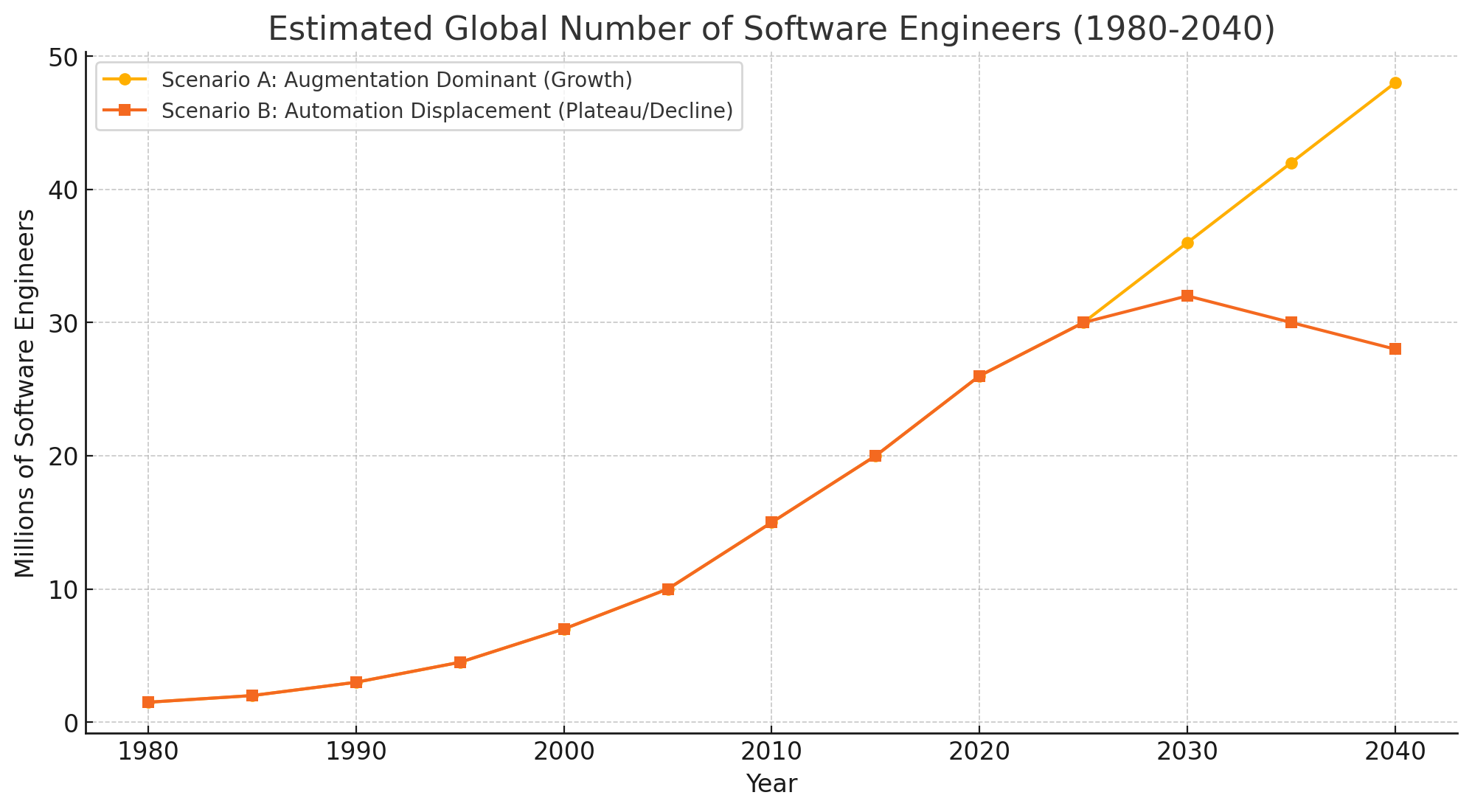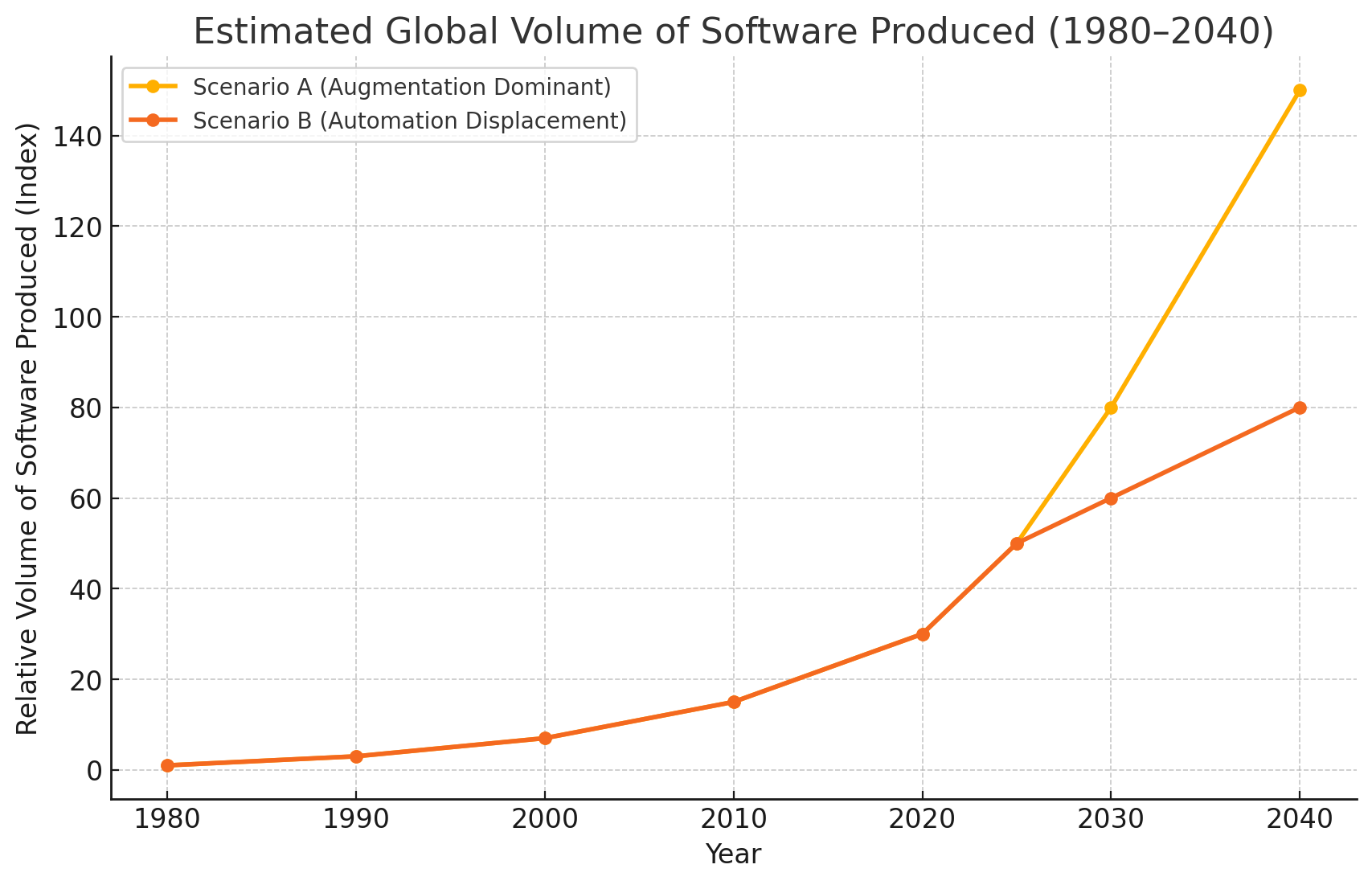Published on
The Industrial Revolution of Software: How Generative AI Continues a Long Arc of Automation
As a software engineer and engineering leader, I've been reflecting on the shifts generative AI is bringing to our work. The speed, scale, and impact of these changes remind me of a historical parallel: the industrial revolution, not in abstract industry terms, but in what it meant for individual craftsmen like automotive mechanics and coachbuilders.
In this post, I explore the similarities and differences between these revolutions; focusing on automation, workforce impacts, evolving roles; and reflect on my own experience leading software engineering teams through this transformation.
A Historical Parallel
During the industrial revolution, machines automated the skilled labor of individual craftsmen. Where once an automotive mechanic or coachbuilder hand-crafted parts, factories introduced assembly lines, automated tools, and mass production techniques. These tools reshaped the role; many tasks that once required bespoke craftsmanship became standardized, streamlined, and automated.
Today, generative AI is automating cognitive work for software engineers. Large language models like GitHub Copilot, OpenAI's GPT, and Claude are writing code, generating documentation, writing tests, and helping debug errors. What factories were to mechanics, these AI models are becoming to software engineers.
I'm reminded that despite automation, not all craftsmanship disappeared. I have a friend who is a coachbuilder working on classic cars. He restores old e.g. Maserati, Mercedes, and Facel Vega vehicles to their original beauty, using techniques unchanged for generations. Craftsmanship persists, but its niche has narrowed. Thought Bubble: I wonder if the software engineering role will follow a similar trajectory?
Automating Skilled Labor
The first most obvious similarity with the historical parallel is automation of skilled, previously manual work.
In automotive history, machines automated forging, machining, and painting. Today, AI coding assistants automate boilerplate code, generate API from specifications, and propose architectural scaffolding.
GitHub reports that Copilot already writes 46% of code in projects where it's used. McKinsey estimates that 30–45% of a software engineer's tasks could be automated within the next 5–10 years.
Like mechanics adopting powered tools, software engineers are shifting from writing most of the code, to curating, reviewing, and steering AI-generated output; while still ensuring quality, security, privacy, and safety in critical systems.
Augmentation Before Replacement
Despite fears of obsolescence, history shows that augmentation precedes replacement.
Automotive factories still needed skilled mechanics to operate, tune, and maintain machines. Similarly, generative AI still requires software engineers to steer, validate, and integrate AI-generated code, particularly to ensure security, privacy, and safety compliance. We aren't replacing engineers; we're changing their role from coder to curator, builder to conductor.
Democratizing Software Creation
Another shared impact is lowering the barriers to entry.
Machines allowed less-trained workers to operate assembly lines. Today, AI coding tools enable the less or non-technical to build software faster and more easily. We're seeing an expansion of low-code, no-code, and AI-assisted development, widening participation in software creation.
But democratization doesn't stop at traditional software. Generative AI is also reducing the barrier to entry for previously inaccessible or highly specialized domains. Tasks like writing quantum computing programs, building custom programming languages, or designing complex compiler optimizations; once the domain of niche experts; are becoming more approachable through AI-driven code generation, assisted explanations, and tooling support.
By automating low-level syntax and boilerplate, generative AI lets more people engage directly with higher-level problem solving, experimentation, and innovation. Engineers can now spend more time conceptualizing algorithms, designing architectures, and validating outcomes, rather than wrestling with the underlying technical complexity.
However, democratization also introduces risks; as more people can build software, ensuring security, privacy, and robustness becomes a shared responsibility.
In this sense, AI doesn't just democratize software creation for novices; it elevates experts toward higher-value activities, freeing cognitive bandwidth from rote implementation toward strategic thinking, domain modelling, and systems design.
The question remains though, will this democratization reduce demand for skilled engineers, or shift their work toward higher-value activities.
Impact Predictions
I have generated the following back-of-napkin projections using data from Evans Data and Octoverse for two potential scenarios.
- Scenario A – Augmentation: AI increases demand for software across industries, with engineers focusing on integration, supervision, research, and complex system design.
- Scenario B – Automation: broader automation reduces demand for existing generalist roles, while growing specialized AI-related positions.
I have given thought to risks around e.g. security, privacy, and safety i.e. the demand for human oversight will grow as systems increase their needs for these ilities.
Workforce
History shows that when industries undergo automation, workforce structures shift dramatically.
- In the early 1900s, car assembly was slow and largely done by skilled craftsmen, building vehicles piece by piece. With the introduction of the assembly line by Henry Ford in 1913, production times plummeted, and output increased - the time to build a Model T dropped from over 12 hours to about 1.5 hours.
- This didn't eliminate jobs but reshaped them: skilled artisans gave way to assembly line workers, and thousands of new factory jobs emerged, albeit with more repetitive tasks.
- By 1917, the automotive sector in Detroit had expanded, with over 90,000 individuals employed in car assembly plants and an additional 44,000 working for parts suppliers.
- Over time, further automation (like robotic welding and painting in the 1970s-80s) reduced the need for human labor in some roles, but increased demand in others - particularly in robotics maintenance, automation programming, and industrial design.
- More recently, the rise of autonomous vehicles and electric drivetrains has shifted focus again, pushing automotive marques to invest in software engineering, data analysis, and battery technology.
Will generative AI do something similar for software engineering?
I suspect we will still see growth in the number of software engineers, even as automation rises.
What I envision based on the numbers before us is something like:

Software Volume Production
Generative AI doesn't just automate code; it increases the total volume of software produced. With faster development comes more systems needing maintenance, reviews, and evolution.
Looking at the impact on automotive industry production offers valuable parallels. Before the assembly line, annual car production numbers were small - Ford produced only around 10,000 Model Ts in 1909. But by 1925, Ford was producing over 2 million vehicles a year, a massive scale-up enabled by automation and standardization. (MODEL T FORD PRODUCTION)
This growth didn't just increase vehicle numbers - it also led to the rise of multiple automotive marques (brands) worldwide. From a few early manufacturers, the market expanded to dozens of companies across Europe, North America, and later Asia, each utilizing mass production to build recognizable brands and global reach.
If we apply this lens to generative AI, we might anticipate a similar impact: not just more software, but an explosion of diverse software solutions, tools, and platforms - each optimized, branded, and scaled up for niche and global markets alike.
What I envision based on the numbers before us is something like:

Evolution of Roles
As automotive factories created roles for machine operators, supervisors, and mechanics maintaining machines, AI is creating e.g.:
- AI/ML engineers
- Prompt engineers
- AI governance specialists
- Human-in-the-loop designers
We're shifting more and more from writing every line of code, to designing, orchestrating, and maintaining complex augmented systems.
More to Maintain
Every line of AI-generated code adds to the software ecosystem needing maintenance. As I discussed in Architecture for AI-Driven Development, AI increases software quantity; oversight, security, and maintenance needs scale alongside it.
This doesn't reduce the need for engineers; it increases their responsibility for long-term custodianship.
My Journey Integrating Generative AI
In my role as Head of Engineering, I have structured a generative AI engineering approach that currently uses Codeium.vim, Claude, and ChatGPT for code generation, re-factoring, documentation, and architecture analysis, achieving:
- 50–75% reduction in lead time
- 50–75% increase in deployment frequency
- Zero deviation in change failure rate
This has resulted in delivering value sooner, with higher quality and lower cost.
Integrating generative AI allowed me to:
- Shift toward higher-value, research-based activity
- Accelerate architecture analysis and documentation
- Focus on quality, security, and oversight
Resistance and Adaptation
The industrial revolution had Luddites smashing machines. Today, some engineers may resist AI coding assistants; worried about quality, control, ethics.
History shows adaptation requires developing new skills and embracing new tools. Software engineers will need new skills in prompting, supervising, and governing AI.
Just as the industrial revolution spurred new training pathways, engineers today must prioritize continuous learning in AI ethics, governance, and augmented development practices.
There was a time when software engineers had to read code from books, typing it line by line to learn or replicate a program. Each evolution; compilers, IDE, version control, the internet, open source, SaaS; brought a new leap in productivity.
Generative AI is not the first automation; it's the latest in a long arc. From my perspective, the industrial revolution for software engineers began long ago; generative AI is simply another powerful tool and automation step in that continuum.
Conclusion
Generative AI is transforming the work of software engineers much like the industrial revolution transformed automotive mechanics and craftsmen. Both revolutions automated skilled labor, lowered entry barriers, redefined roles, and increased system complexity.
Like my friend restoring classic Maserati and Mercedes cars by hand, some engineering craftsmanship will endure.
The future belongs to those willing to learn, adapt, and lead. Whether overseeing AI systems or crafting software by hand, software engineers remain essential to building and sustaining the digital world.
